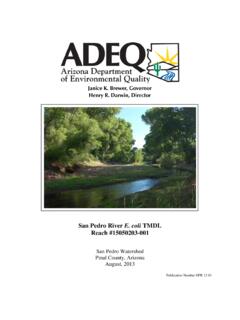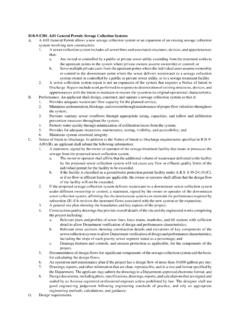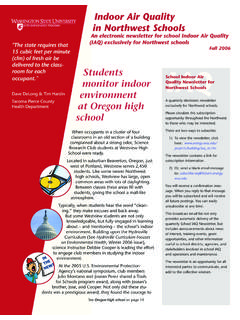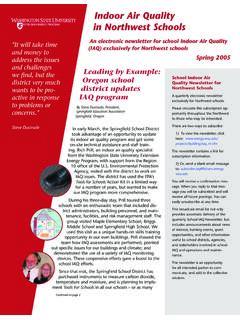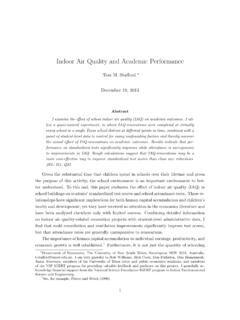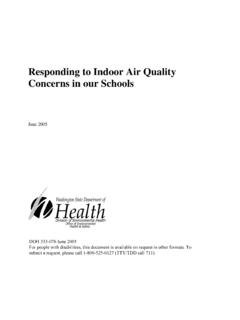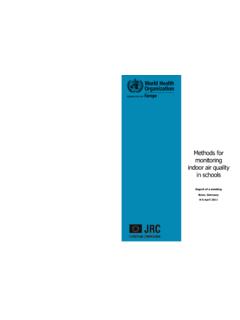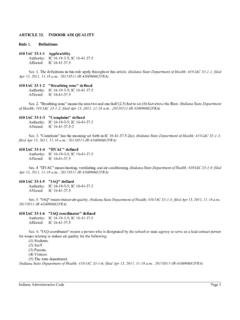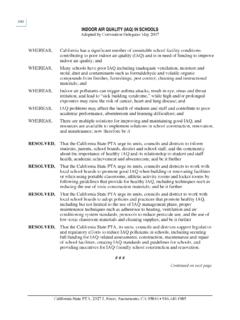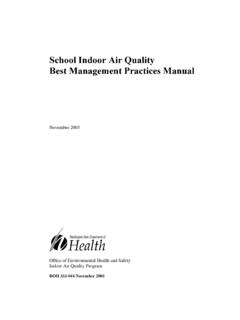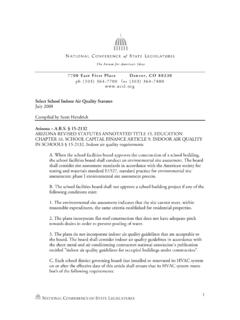Transcription of Indoor Air Quality Asthma Triggers Manual for Child Care ...
1 Indoor Air Quality Issues for Child Care Facilities TRAIN - THE - TRAINER GUIDE. CHILDREN'S ENVIRONMENTAL HEALTH PROJECT. We would like to express appreciation to all the individuals and agencies that supported the creation of this document by providing input and technical assistance. Hazel Chandler, The Phoenix Children's Hospital and Maricopa Asthma Coalition Diane Eckles, Arizona Department of Health Services Children's Environmental Health Bruce Liggett, Association of Supportive Child Care Lourdes Ochoa, Arizona Department of Health Services Child Care Licensing Beverly Plonski-Fuqua, Arizona Department of Health Services Office for Children with Special Health Care Needs Manuela Rehm-Bowler, Arizona Department of Environmental Quality Children's Environmental Health Project Carolyn Wilmer, City of Phoenix Head Start ADEQ's Collaboration Partner ARIZONA DEPARTMENT OF HEALTH SERVICES (ADHS).
2 TABLE OF CONTENTS. Introduction .. 1. Lung Development .. 2. Air Quality .. 4. Outdoor .. 5. Indoor .. 6. Asthma .. 15. Asthma Friendly Schools.. 17. School Bus Idling .. 18. Appendix Cleaning Supplies .. 22. Games.. 23. Checklists Warning Signs .. 25. Classroom .. 27. School .. 29. Environmental Pledge.. 31. Asthma Patient Action Plan .. 33. Helpful References .. 35. Community Resources .. 37. ACT for Asthma Poster from Dept. of Health Services .. 39. Introduction A s a childcare provider, you have been entrusted by parents with their most valuable asset their children. You may spend more time with a Child than any other adult. Helping to raise the children in your care, you can have a huge impact on their health and well-being. Do you know how to protect each Child from the harmful effects of the environment we live in?
3 Do you know what harmful things are actually in the environment you provide? Basic common sense tells you when something just isn't right. Little Johnny keeps coughing the day after pesticides have been sprayed near his crib or Sarah just looks really tired and gray right after the room has been vacuumed. These are examples of what could be patterns. Patterns do not emerge overnight. You may see pieces of what is happening, and the family may see other pieces. Neither of you realizes that the other has the missing piece. It is important that you write down observations about a Child 's health, and share this information with the parents. Childcare facilities and schools often have problems with Indoor air Quality because there are a lot of people in a small space. Money to maintain or upgrade buildings may be limited.
4 Childcare providers and parents may not even be aware of the environmental risks children may experience in outdated buildings. Poor Indoor air Quality can increase the spread of communicable diseases and cause discomfort such as congestion and coughing for children and adults. Children and childcare workers may miss school far too often by our failure to recognize and correct environmental health risks. Conditions that trigger Asthma attacks can lead to hospitalization and even death for some children and adults. The number of children with Asthma is increasing, and we need to protect children by reducing Triggers that can cause an Asthma attack. It is important to know how to recognize an Asthma attack and what action to take. This guide is meant to help childcare providers improve the Indoor air Quality at their centers by providing information on harmful Indoor air and how to achieve a healthy environment.
5 1. Lung Development Children's lungs are still developing until they reach about 6-8 years of age. During this time, children's lungs can easily be damaged by pollution or infection. Children breathe 4. times as much air per pound of body weight as adults! This means that children breathe in more pollutants than adults. Children living in cities are exposed to pollution from cars and industry, while children living in the country may be exposed to dust and pesticides from farming. Parents and teachers can take action in the home and classroom to protect children's lungs. This section will explain what our lungs do, and how they are affected by the Quality of our air. What do our lungs do, how do they work and how big are they? Breathing is an automatic function that supplies the body with the oxygen necessary to run all of the body's systems.
6 Our lungs inhale and exhale about 20,000 quarts of air every day. (Visualize a 16-wheel semi truck carrying milk.) The lungs are the largest organ inside the body. If you were to unfold all of the lung tissue it would stretch to almost the size of a tennis court. We breathe in oxygen through very thin sac like objects called lungs that give oxygen to the blood received from the heart. The blood then carries the oxygen to the rest of the body and exchanges it for carbon dioxide, which is expelled when we exhale. For a long healthy life, all of us need to protect our lungs. What do they look like inside? See the difference between healthy and unhealthy lungs. The Quality of the air can make a difference. Smoking is a real culprit. 2. Each Part of our Respiratory System Plays a Role Many parts of the respiratory system serve as air filters.
7 Our nose, mouth and lungs filter incoming oxygen as we breathe. The air passes through the windpipe (also called the trachea) and into the lungs, through smaller and smaller branches, until it reaches tiny sacs (alveoli) which are surrounded by blood vessels. The oxygen moves from the alveoli, into the blood, and the heart pumps the oxygen-containing blood to the rest of the body. The more dirty the air we breathe, the more difficult it is for our body's filtering (respiratory). system to protect our lungs and other body parts from harm. 3. Air Quality Air pollutants Our air Quality is measured by the number and kinds of pollutants in the air. Sometimes we can see the air pollution, and sometimes we can't. Today's technology allows us to determine whether the pollutants are there and if they pose environmental health risks.
8 Air pollution is made up of big particles (called PM10 Particulate Matter), small particles ( Particulate Matter), Carbon Monoxide (CO), Carbon Dioxide (which comes from our own systems), and Ozone (O3). What does each type of air pollution do and how does it affect my lung capacity? Big particles (PM10) are made up of items that are about 10 microns in size (the thick- ness of a strand of hair). PM10 particles plug up your lungs by sticking to the inside of the branches, forcing your lungs to make mucous to trap these particles. Your body then coughs to get rid of the mucous. These particles are found in windblown or construction dust, tire dust created when a tire hits the pavement, wood stoves and fireplaces, wildfires and trash burning. PM10 is often responsible for the haze we see.
9 Small particles ( ) are about the size of bacteria. Bacteria are so tiny they aren't visible to the eye. These very tiny particles can come from smoke from brush fires, heavy metals or toxic chemical fumes. Because these particles are so small, they can go very deeply into the lungs. They stay there and can cause continuing irritation, sometimes even leading to death by cancer. Carbon Monoxide (CO) is created by car exhaust. This is especially dangerous to our lungs because Carbon Monoxide can travel through the very thin sac-like lung walls and mix with the blood. The body will not get enough oxygen to the blood because the body thinks that the Oxygen and CO are the same. Slowly the body replaces Oxygen with Carbon Monoxide, and it can restrict the flow of oxygen to other organs and even can cause death.
10 Carbon Dioxide is the gas that is released from our bodies after oxygen has been absorbed within our bodies. Simply put, we take in oxygen and release carbon dioxide. It is the leftovers after our body is done absorbing oxygen into the system. If too much car- bon dioxide is in the air, we can get too little oxygen, which can give you a headache;. make you sleepy, or dizzy. Ozone created when all the pollutants and particles in the air are exposed to heat and sunlight. That is why High Ozone days are more frequent in summer months than in winter. Exposure to ozone basically sunburns the inside of your lungs by inflaming your lung lining. Constant exposure can result in decreased lung capacity, premature aging of lungs, increased Asthma , and other lung diseases. 4. Children and the Outdoors Outside play time is important for children to get exercise and to learn motor skills.







